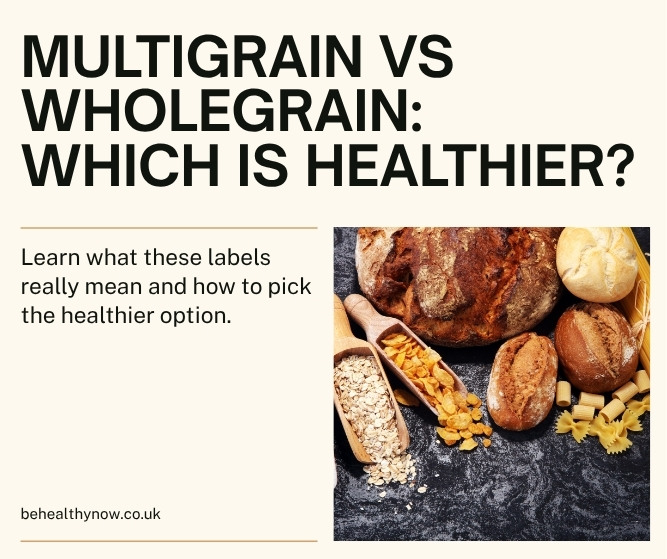
You’re standing in a shop, trying to make better, healthier choices, and then you spot the word multigrain on a loaf of bread, cereal, or something else. You pause and think, is this the same as wholegrain? It sounds so similar…
I’ve been in that exact situation. In a rush one day, I grabbed a box of cereal that said multigrain on the front, assuming it meant the same as wholegrain. Later at home, I realised I’d been wrong. Yes, it had a mix of grains, but most of them were refined. It’s amazing how misleading food labels can be (I honestly think that word should be banned on packaging).
So in this post, I’m clearing it all up — what multigrain and wholegrain really mean, where wholemeal fits in, and how to tell which one is actually better for you. Sometimes it’s not as simple as it seems, and there are a few extra things worth checking too.
In summary:
Multigrain just means a mix of different grains, and they can be refined or whole.
Wholegrain means the entire grain is used (bran, germ, and endosperm) which makes it the healthier choice most of the time.
Table of Contents
What Multigrain and Wholegrain Actually Mean
These two words sound almost the same, but when you look closely, they mean something quite different.
Wholegrain
When a food is made from whole grains, it means the entire grain is used — the bran, the germ and the endosperm. Nothing important has been removed, so the food keeps more fibre, vitamins, minerals and natural goodness. Whole grains help you feel fuller for longer and support digestion.
You’ll often see terms like whole wheat, whole oats or whole rye. They all mean the same thing: the grain hasn’t been refined.
Multigrain
Now this one is where things get tricky. Multigrain just means that more than one type of grain has been used – it could be wheat, rice, barley, oats, corn, or rye. Sounds healthy, right? But here’s the catch: those grains can be refined or whole, and there are no rules saying how much of each type must be included.
That means a product labelled multigrain could contain mostly refined grains (like white rice or refined wheat) with just a sprinkle of whole grains. Another brand might do the opposite and use mostly whole grains – you simply can’t tell from the label alone.
This is why “multigrain” is a marketing word more than anything else. There are no official regulations that define how much whole grain has to be in a multigrain food, either in the UK, US or EU. Every company can use it a bit differently.
Which grains are whole and which are refined?
If this part still feels confusing, here’s a simple way to think about it.
| Grains that are naturally whole (when unrefined) | Common refined versions |
|---|---|
| Oats (rolled oats, porridge oats) | Instant oats (often processed) |
| Brown rice | White rice |
| Whole wheat | White or refined wheat flour |
| Whole rye | Refined rye flour |
| Barley (hulled barley) | Pearled barley |
| Quinoa, buckwheat, millet | Usually used whole |
| Corn (whole cornmeal, popcorn) | Refined cornflour, polenta |
So if you see rice or wheat on a multigrain label without the word whole, it’s always the refined kind, meaning a lot of fibre and nutrients have been stripped away.
That’s why multigrain products can look or sound healthy but may not be as nutritious as you’d expect.
Where Wholemeal Fits In
In the UK, wholemeal is a legally protected word for bread. If something is called wholemeal bread, all the flour used to make it must be wholemeal – no mixing with white flour allowed.
In other countries, the word wholegrain is usually used instead of wholemeal, but it means the same thing – that the entire grain is still there and hasn’t been refined.
A note on rules and standards
Even though the word wholegrain sounds clear, it’s not always strictly defined. The UK, US and EU still lack a firm, universal rule on what percentage of a product must be wholegrain before it can make that claim.
The Whole Grain Initiative has suggested a global definition – that a product labelled as a wholegrain food should contain at least 50% whole grains by dry weight and more whole-grain than refined ingredients – but this isn’t law anywhere yet.
So, the next time you see multigrain or wholegrain on a label, remember: one gives you real fibre and nutrients from the whole grain; the other just tells you it’s a mix. And that mix could include plenty of refined stuff.
Which Is Healthier (and How to Tell by Looking at the Label)
Now that we know multigrain and wholegrain don’t mean the same thing, the next question is: which one is actually better for you?
In most cases, wholegrain wins. Because it contains all parts of the grain, it naturally provides more fibre, vitamins, and minerals. That extra fibre helps keep you full for longer, supports digestion, and even helps manage blood sugar levels better.
Multigrain, on the other hand, might sound fancy but can be hit or miss. It could be packed with nutritious whole grains, or it could be mostly refined grains with just a sprinkle of the good stuff. The label alone won’t tell you – you need to take a quick look at the ingredients list.
But here’s the important bit: not every wholegrain product is automatically healthy.
A loaf of wholegrain bread with added sugar, oils, and preservatives isn’t as good for you as a simple one made with just a few wholesome ingredients. The same goes for cereals – some wholegrain cereals are full of sugar, while others, like plain oats or shredded wheat, are naturally wholesome.
So while wholegrain usually comes out on top, it’s worth taking an extra few seconds to check the label – it really makes a difference.
How to Read the Label Like a Pro
Here’s how to quickly work out whether what you’re buying is genuinely healthy or just cleverly marketed.
1. Look at the first few ingredients.
Ingredients are listed in order of quantity. If you see whole wheat, whole oats, whole rye, or whole barley listed first, that’s a good sign. But if it starts with wheat flour, rice, or maize flour, it usually means refined grains are the main ingredient.
2. Check for the percentage of whole grains.
Sometimes you’ll see something like wholegrain flour (54%) or whole wheat (70%) – this makes it easier to compare products. The higher the percentage, the better.
3. Check the fibre.
Wholegrain foods are higher in fibre. Aim for at least 3g of fibre per 100g (that’s considered “a source of fibre”) or even better, 6g per 100g (that’s “high fibre”).
4. Watch the sugar.
Even a healthy-sounding product can have lots of added sugar. Look at the nutritional panel – if it’s over 10g of sugar per 100g, that’s on the higher side. And remember, 4g of sugar equals one teaspoon.
5. Look out for long ingredient lists.
If the list is full of additives, flavourings, and preservatives, it’s a sign the product is highly processed, even if it says “wholegrain” or “multigrain” on the front.
How to Choose Better Products
Now that you know what these words really mean, here’s how to use that knowledge when you’re shopping. You’ll see multigrain and wholegrain on bread, cereals, wraps, crackers and even pasta – but not all of them deserve a spot in your basket.
Bread
Bread labels can be confusing, especially when everything looks brown and healthy.
If you’re in the UK, the safest bet is wholemeal bread – by law it must be made entirely from wholemeal flour. Elsewhere, look for wholegrain listed first in the ingredients.
Good signs:
- Wholegrain or wholemeal flour first on the list
- Around 6g or more of fibre per 100g
- Minimal added sugar (ideally under 3g per slice)
- Short ingredient list – the simpler, the better
Be cautious of breads coloured with caramel or malt extract. They may look wholegrain, but they’re often just brown in colour.
Breakfast Cereals
Cereal boxes love the word multigrain, but many are just refined grains plus sugar. Always check the ingredients first.
Choose cereals where:
- The first ingredient is ideally a whole grain (like whole oats or whole wheat)
- Fibre is at least 4g per serving
- Sugar is low – under 10g per 100g is a good guide
If you want genuinely healthy options, go for plain oats, shredded wheat or low-sugar wholegrain flakes. Add your own fruit for natural sweetness instead of relying on added sugar.
Wraps and Crackers
These can sound healthy but are often made with refined wheat. Pick ones that list whole wheat or wholegrain flour first and contain at least 3g of fibre per 100g.
Compare brands if you can – you’ll quickly spot which one has more fibre and less salt or sugar.
Pasta
Here it’s simple: wholewheat pasta is the better choice. It’s higher in fibre and keeps you full for longer.
“Multigrain pasta” might sound good, but it’s often just refined wheat with a few extra grains added for marketing. If you want something different, try brown rice, lentil, or chickpea pasta – they’re higher in both fibre and protein.
Quick Takeaway
Don’t rely on the front of the pack.
Turn it around and check the ingredients. Choose foods where wholegrain or wholemeal comes first, fibre is high, and sugar is low – those are the ones that actually deliver on their healthy image.
FAQs
Is multigrain ever healthy?
It can be, depending on what’s inside. If most of the grains are whole, the fibre is around 6g or more per 100g, and the sugar is low, ideally under 10g per 100g for cereals or under 5g per 100g for bread, it can be a healthy choice.
Is brown bread the same as wholemeal bread?
Not always. Some brown breads get their colour from caramel or malt extract rather than whole grains. Wholemeal bread, on the other hand, must be made from 100% wholemeal flour in the UK.
Which is better for blood sugar and diabetics?
Wholegrain foods are generally better because they release energy more slowly and help keep blood sugar levels steadier. Multigrain can vary — some versions are mostly refined grains, which can cause quicker spikes.
What about “whole wheat” – is that wholegrain?
Yes. “Whole wheat” simply means it’s made from wholegrain wheat – it’s another way of saying the same thing.
Final Thoughts
Next time you see multigrain or wholegrain on a label, don’t take it at face value. Turn the pack around and check what’s really inside.
If wholegrain or wholemeal comes first in the ingredients, the fibre is high, and the sugar is low – that’s your winner. And remember, a short ingredient list usually means a less processed, better-quality product.
Labels can be confusing, but once you know what to look for, choosing healthier options becomes much easier.

























